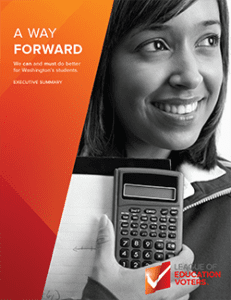A child’s education should be a continuum with seamless transitions from early learning through postsecondary education. The League of Education Voters (LEV) is pleased to release its vision for an expanded definition of basic education.
We can and must do better for Washington’s students.
Washington’s policymakers have spent much time, money, and intellectual capital trying to overhaul our state’s education funding system—multiple task forces, studies, work groups, legislative efforts—and yet, we lack a plan for ample, equitable, and stable funding. In addition, our definition of “basic education”—what this funding system is supposed to pay for—doesn’t go far enough to prepare our kids for college or career.
The Washington State Supreme Court found that the state was violating its constitutional obligation to amply fund basic education in the McCleary v. State of Washington funding case. Lawmakers were given a 2018 deadline to fix how we fund basic education. The passage of Initiative 1351 to lower K–12 class sizes statewide magnifies the intense pressure on the Legislature to determine a viable funding plan for public education. Though the 2018 deadline looms, the Court found the Legislature in “contempt of court” last fall, giving them until the end of the 2015 legislative session to make significant progress on a funding plan. While the funding issues are paramount to the Court, this time frame provides a unique opportunity to reflect on what our kids really need from our public education system
to succeed.
A child’s education should be a continuum with seamless transitions.
While we have made progress in improving the K–12 system, we have not changed the way we think about what a basic education entails. A child’s education should be a continuum with seamless transitions. Our state’s approach to providing that education is hamstrung by silos, bureaucratic fights, politics, and battles pitting different parts of that child’s education against each other.
The League of Education Voters (LEV) endorsed the re-definition of basic education developed by our Legislature in 2009 (it includes smaller class size, full-day kindergarten, transportation, materials, and supplies) upon which McCleary is based, but we also advocated, based on our leadership and support for Initiatives 728 and 884, that the definition should include early learning and higher education.
A new definition of basic education must address one of the critical and more pernicious challenges we face statewide: a growing achievement gap between low-income kids, kids of color, and English Language Learners; and their white, more affluent counterparts. Too many kids, particularly low-income kids, arrive at kindergarten already behind. At the other end of the education spectrum, all data point to the need for a postsecondary degree or certificate in preparation for the jobs of today and tomorrow.
We know there is no single policy solution that will close the opportunity and achievement gaps for Washington students.
We believe the pathway to providing a high-quality public education for all students begins with identifying and funding what works.
For the League of Education Voters, this requires a new definition of basic education, which includes early learning, strategic investments in teacher compensation and professional learning, and at least two years of postsecondary education for each Washington student. We can and must do better for Washington’s students.
LEV’s vision for an expanded definition of basic education is aspirational, yet achievable, and will spark change in Washington state’s investment in the public education system. This vision ensures all students in Washington have access to a high-quality public education required by our state’s Constitution.
In order to achieve that vision, Washington’s basic education system must:
- Prioritize students and their learning
- Invest in proven strategies to close the opportunity and achievement gaps
- Recognize that students who need more support to reach high standards should get more support
- Establish a stable salary system and program of professional learning that helps attract and retain the best teachers and administrators while providing opportunities for growth and improvement
- Embrace rigorous and relevant learning opportunities for all
- Acknowledge the importance, and necessity, of involving parents and caregivers
- Guarantee that the quality of a student’s education is not determined by his or her ZIP code.
If we are to prepare all kids for success, it is critical that our investment priorities are proven effective at closing systemic opportunity and achievement gaps. Funding for public education in our state must include substantial resources focused on addressing and ultimately eliminating these gaps in academic outcomes.
Read more
- Early learning
- K–12 education
- Postsecondary education
- Funding a way forward
- Addendum and sources
- Download A Way Forward
- Download the executive summary
Infographic: High-quality public education
Join us
En Español
- Leer el Resumen Ejecutivo
- Descargar el Resumen Ejecutivo